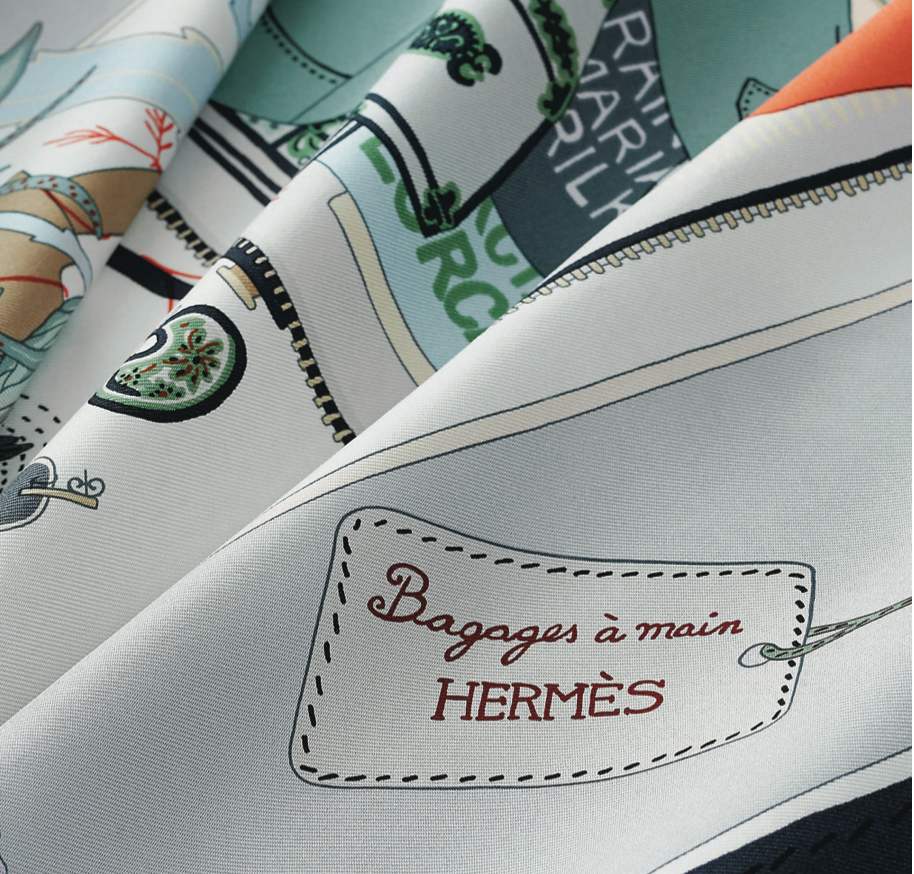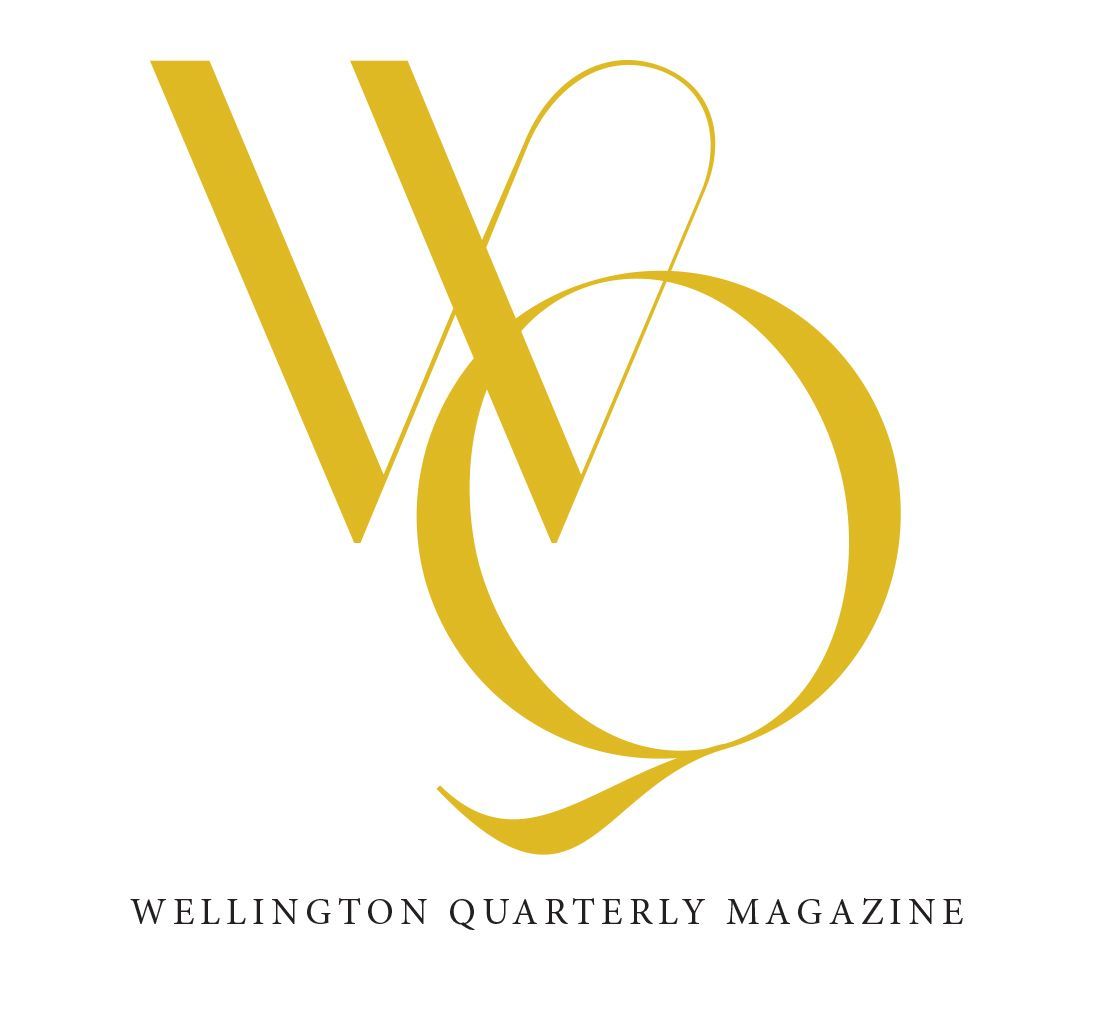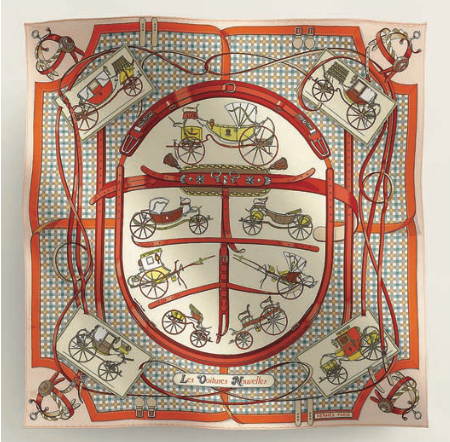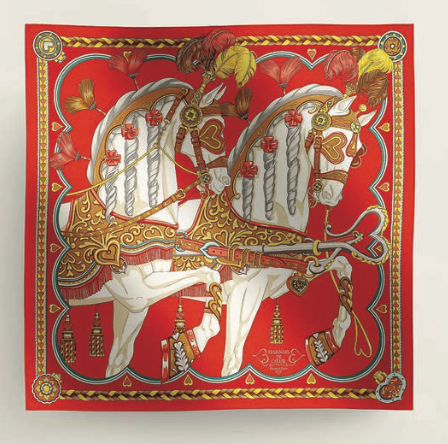THE HÈRMES SCARF
Live Beautifully
An Object Of Historical Importance

By Claire-Marie Schkéve
In 1937, one hundred years after the luxury house Hermès was founded, it created its first silk scarf, an item that is recognized worldwide as a symbol of wealth and style.
With over 50,000 actual references in its historic design library, the scarves are offered in six to eight color variations per design, with over 40 new designs offered each year and with a design process that takes as long as 2 years to bring a new design to market. Today, silks represent 7% of the company’s annual revenue of $13.5 billion. The scarf, (along with the Hermès tie) which appeared in 1951, and all the house’s other silk objects, are made and finished by hand in the Hermès workshops situated in the Lyon area of France, the historic cradle of the French silk trade and textile industry.
Expert hands take care in every stage of the production process, from weaving, engraving, dyeing and printing the fabrics, to finishing and hand rolling the edge stitching. Over 800 people work on this product offering, which is part of the house’s Holding Textile Hermès division. The scarf exudes instant recognizable style. Queen Elizabeth, Grace Kelly, Greta Garbo, Audry Hepburn, Luciano Pavarotti and scores of style icons have worn and collected the Hermes “carré”. It is a symbol of contemporary culture and impeccable style shared all over the globe.
Made from an exclusive silk twill, an incredibly soft material with a bright white quality, it’s serge weave gives it its specific hold and feel. Woven obliquely, the silk is crease-resistant and over time will soften and develop a wonderful patina. Because of its roots as a saddle and bridal maker in the 1800’s, equestrian sport and proper is a theme most notable in many of the silks Hermès offers. One of the most famous is ‘Brides de Gala” designed by Hugo Grygkar in 1957. Its assortment of stirrups, brid- als, reins, crops and bits have been reinturpretted and reinvented hundreds of times in colors and shapes unique in each display.
Probably the most interesting part of the design process of these textile gems comes from the roots of the artists Hermès commis- sions to create them. To date, Hermès has worked with well over 300 artists across the globe for the creation of one of their scarves. One such artist is Kermit Oliver of Waco, TX, Oliver began as a humble painter hoping to sell his art wherever he could. Like many artists, earning a living was a challenge for Oliver so he held down a full-time job as a US Postal worker and picked up his brush in the evenings and on weekends.
Oliver was first discovered by Lawrence and Shelby Marcus, the founders of the Dallas department store Neiman Marcus. Lawrence Marcus was notified of Hermès’ search for scarf designers and Oliver, whose art was previously purchased by Marcus, immediately came to mind. Oliver’s panache and his Flores et Flore du Texas design, a romantic vintage detailed depiction of the state for the sesquicentennial, quickly became a favorite of Hermès.
Oliver was known to paint from the outside in. A style unique for painters where the painter starts with his most vivid direction along the boarders and blends it seamlessly towards the middle. Some of his most famous designs included one whose boarder consisted of more than 50 native animals. Hermès’ purchase of this design and over 140 others, thereafter, made Kermit Oliver one of the best-known artists to design scarves for fashion house.
Offered in different squares, lengths and widths, the scarves have an incredible versatility to those who covet them. Possibilities for styling Hermès scarves are seemingly endless, from using a square to adorn the handle of a Birkin or Kelly, festooned to the pant waist as a belt or tied tight to the scalp as a headband. Social media users have created scores of videos on the many unique ways to wear or tie their scarves which number in the hundreds. Collectable, coveted, adored and renown, the Hèrmes silk scarf may outlive us all. e
Claire-Marie Schkéve is a historian and writer who lives in Paris, France. She has written pieces on ‘The Louis Vuitton Trunk’, ‘The Cartier Love Bracelet’ and “The Macarons of Paris”, amongst other well-known luxury French items. She owns one Hermès scarf.
Photos: 1) A concerned-looking Queen Elizabeth II, biting her nails while watching the Windsor Show circa 1989, accessorized with her signature hermès scarf. (Alamy stock photo) 2) Mrs. Kennedy, wearing an Hermès scarf, with President Kennedy and others watching the America's Cup Race, 1962. 3) Princess Grace of Monaco, her arm in a colorful sling, boarded Aristotle Onassis’ yacht for a dinner party in Monaco’s harbor on august 27, 1959, with her husband, Prince Rainier, following closely behind. According to the palace, the princess had been stung by a wasp two days earlier at her Mont Agel summer residence, causing her significant pain. (AP photo) AP. 4) A Hermès advertisement from 1937, featuring the newly introduced silk scarf.








